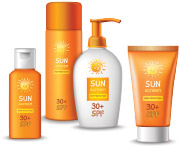1. Preventing sun damage is much easier than restoring wrinkles. It is always easier to prevent than it is to reverse. Sun damage can cause wrinkles, discolored skin, and more serious health consequences. In some cases, once the damage is done, there is no going back.
2. Avoid deep exfoliating procedures and chemical peels during the summer. These treatments make the skin more photosensitive by removing layers of the epidermis that can act as a protective shell. The same is true for skin care products formulated with retinol, alpha hydroxyl acids, and other lightening agents. Products containing these ingredients are best used in the evening.
 3. Protect skin with broad-spectrum sunscreen. The SPF number on the bottle indicates how much a client’s safe, sun-exposure time can be extended. Have clients determine the time it takes for their unprotected skin to start turning red on a sunny day. Their safe, sun-exposure time depends on their genetic disposition, location, and the time of day (the sun is most active between 11 a.m. and 4 p.m.). For example, if their skin starts to change color after 10 minutes, by applying sunscreen with SPF 30, their safe, sun-exposure time will be extended 30 times. After 300 minutes, clients will need to reapply sunscreen.
3. Protect skin with broad-spectrum sunscreen. The SPF number on the bottle indicates how much a client’s safe, sun-exposure time can be extended. Have clients determine the time it takes for their unprotected skin to start turning red on a sunny day. Their safe, sun-exposure time depends on their genetic disposition, location, and the time of day (the sun is most active between 11 a.m. and 4 p.m.). For example, if their skin starts to change color after 10 minutes, by applying sunscreen with SPF 30, their safe, sun-exposure time will be extended 30 times. After 300 minutes, clients will need to reapply sunscreen.
4. Location determines the strength of the ultraviolet rays that penetrate the skin. If clients are in the water or the snow, their safe, sun-exposure time diminishes significantly, as ultraviolet rays are reflected off the surface of snow or water.
5. The sun is most active at the equator. When traveling south, more protection is needed. Along with sunscreen, advise clients to wear protective hats and clothing to avoid serious sun damage.
 6. Be very careful when at higher elevations. The earth’s atmosphere helps filter ultraviolet rays, so if clients are at higher elevations, like the mountains, they are less protected.
6. Be very careful when at higher elevations. The earth’s atmosphere helps filter ultraviolet rays, so if clients are at higher elevations, like the mountains, they are less protected.
7. Zinc oxide is a great active ingredient for sunscreens. It provides broad-spectrum protection by physically reflecting ultraviolet rays. It has been safely used for generations and is preferred over nanoparticles, which are not as effective.
8. Food can affect how skin responds to the sun. Processed foods with trans fats can contribute to wrinkles, skin discolorations, and other more serious conditions. Colorful, organic fruits and vegetables filled with antioxidants, like tomatoes, will support the skin during sun exposure.
 9. Photosensitivity is a side effect of some medications like Accutane, Benadryl, and tetracycline. If clients have to take medical drugs, have them check the list of side effects to determine if they need to take extra precautions in the sun.
9. Photosensitivity is a side effect of some medications like Accutane, Benadryl, and tetracycline. If clients have to take medical drugs, have them check the list of side effects to determine if they need to take extra precautions in the sun.
10. Elevated estrogen levels and other hormonal changes often result in heightened photosensitivity. This photosensitivity can lead to hyperpigmentation. For example, melasma, the mask of pregnancy, presents as skin discoloration. Women who are taking birth control pills or who are on hormone replacement drugs may also experience similar side effects, unless they take extra measures to protect themselves from the sun.
 Elina Fedotova is the CEO of Elina Organics and the founder and president of the Association of Holistic Skin Care Practitioners. She has worked as a licensed aesthetician, cosmetic chemist, herbalist, and educator for more than 20 years. She believes that healthy skin is the result of a balance between body, mind, and spirit.
Elina Fedotova is the CEO of Elina Organics and the founder and president of the Association of Holistic Skin Care Practitioners. She has worked as a licensed aesthetician, cosmetic chemist, herbalist, and educator for more than 20 years. She believes that healthy skin is the result of a balance between body, mind, and spirit.